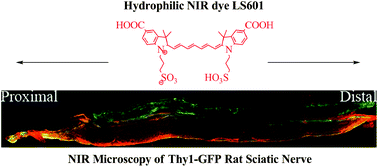Current imaging modalities lack the ability to quickly assess and classify nerve injury for predicting favourable versus unfavourable healing outcomes, which could minimize episodes of chronic pain and loss of function by allowing for early intervention. Thus, the development of a technique to noninvasively assess peripheral nerve damage is of critical importance. While the development of nerve specific near infrared (NIR) molecular probes capable of such diagnostics constitutes our long term goal, initial studies to identify a NIR dye for constructing such a probe are required. We have evaluated the properties of a novel highly hydrophilic and functionalizable polymethine dye, and its more hydrophobic analogue indocyanine green, within the sciatic nerve of rats following intra-nerve injection. The reporting ability of both dyes at critical depths for nerve imaging, the importance of hydrophilicity on dye transport through nervous tissue, and their toxicity—or lack thereof—to the neural environment have been evaluated. The results suggest that the novel NIR dye is an appropriate fluorescent reporter for use in designing nerve-specific optical molecular probes for non-invasive diagnosis and classification of nerve injury.

You have access to this article
 Please wait while we load your content...
Something went wrong. Try again?
Please wait while we load your content...
Something went wrong. Try again?


 Please wait while we load your content...
Please wait while we load your content...